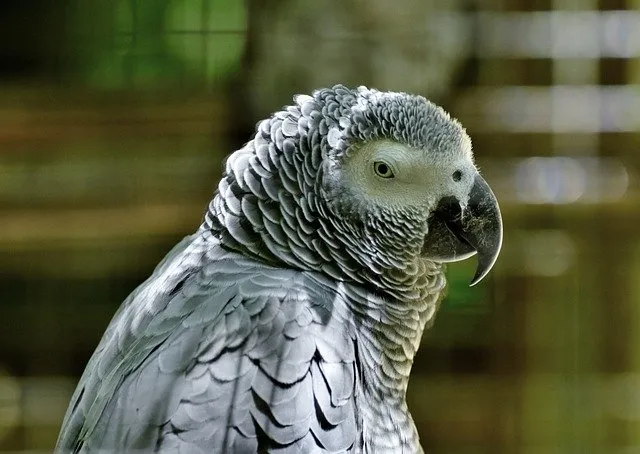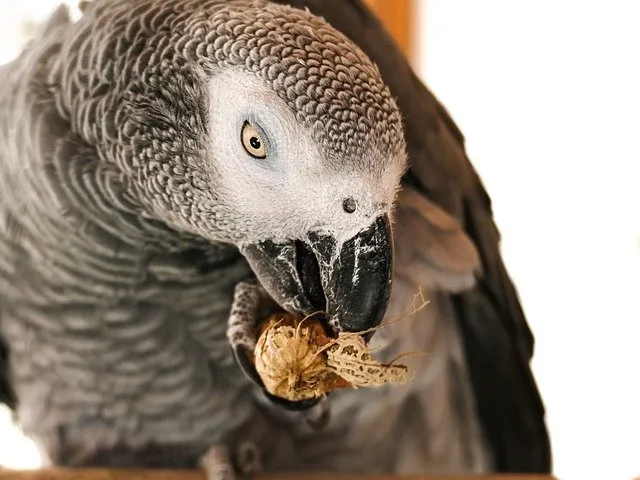As an Amazon Associate I earn from qualifying purchases.
What do African Gray Parrots eat? It’s a question that often lingers in the minds of bird enthusiasts and seasoned parrot parents alike. These intelligent and talkative companions demand more than just affection; they have a palette that deserves attention and care. In this discourse, we’re delving into the culinary world of African gray Parrots, decoding the intricate dance of nutrients that keeps these majestic birds surviving and thriving. From the crunchy goodness of pellets to the rainbow spectrum of fresh fruits and veggies, we’ll dissect the elements that make up a well-balanced diet. So, explore a flavorful journey into the gastronomic preferences of our feathered friends, exploring the nuances of ‘What do African Gray Parrots eat?’ for a happier and healthier companionship.
What Do African Gray Parrots Eat?
African gray Parrots, renowned for their intelligence and charming personalities, make wonderful companions. Ensuring their well-being involves more than love and attention; a crucial aspect is providing a balanced and nutritious diet. In this guide, we’ll explore the diverse culinary preferences of African gray Parrots, shedding light on the essential foods that contribute to their health and happiness.
1. Pellets:
African gray Parrots benefit significantly from high-quality pellets. These commercially formulated diets are specifically designed to meet their nutritional needs. Look for pellets that are free from artificial additives and colors. Pellets offer a balanced mix of vitamins, minerals, and amino acids, ensuring your parrot gets a solid nutritional foundation.
2. Fresh Fruits:
Various fresh fruits add flavor and nutrition to your African gray’s diet. Berries, such as blueberries and strawberries, are rich in antioxidants. Apples and pears provide essential vitamins, while oranges and kiwis contribute vitamin C. Ensure that fruits are cut into manageable sizes and any seeds or pits removed to prevent choking.
3. Vegetables:
Dark, leafy greens like kale and spinach are excellent sources of calcium and other vital nutrients. Carrots, sweet potatoes, and bell peppers offer color and essential vitamins. Integrate a mix of vegetables to create a visually appealing and nutritious plate for your African gray.
4. Nuts and Seeds:
Nuts and seeds are rich in healthy fats and proteins, contributing to your parrot’s overall well-being. Almonds, walnuts, and sunflower seeds are popular choices. However, due to their high-fat content, moderation is key. Provide them as occasional treats rather than staple foods to maintain a balanced diet.
5. Whole Grains:
Incorporate whole grains like quinoa, brown rice, and whole wheat pasta to provide your African gray with a healthy source of carbohydrates. These grains offer sustained energy and complement the protein and vitamins derived from other food sources.
6. Lean Proteins:
Lean protein sources are crucial for muscle health, and cooked chicken, turkey, and eggs are excellent choices. Ensure meats are seasoning-free, as excessive salt and spices can be harmful. Scrambled or hard-boiled eggs offer a protein-packed treat.
7. Calcium and Grit:
African gray Parrots require a source of calcium for strong bones. Cuttlebone and mineral blocks are excellent choices to fulfill this need. Additionally, providing grit can aid digestion by assisting in the breakdown of food in the gizzard.
When to feed African Gray Parrots?
Feeding African Gray Parrots at the right time is crucial for their health and well-being. A consistent feeding schedule helps regulate their metabolism, supports digestion, and ensures they receive the necessary nutrients at optimal times. Here’s a detailed guide on when to feed African Gray Parrots, emphasizing the importance of timing and portion control:
1. Morning Routine:
Start the day by offering a portion of high-quality pellets. This provides a nutritional foundation for the day ahead. Aim for a portion size recommended by the manufacturer, typically ranging from 1/4 to 1/2 cup, depending on the size and weight of your African Gray.
2. Midday Snack:
Around midday, introduce a small serving of fresh fruits and vegetables. This snack provides a burst of vitamins and minerals. Include a variety of fruits like berries, apples, or citrus, along with colorful vegetables such as carrots or bell peppers. The portion size can be smaller than the morning pellet serving.
3. Afternoon Engagement:
Utilize the afternoon to engage your African Gray in interactive feeding. Incorporate puzzle feeders, foraging toys, or hanging treats to stimulate mental and physical activity. This not only keeps them entertained but also encourages natural foraging behaviors.
4. Early Evening Meal:
To ensure consistent nutrition throughout the day, offer another serving of pellets in the early evening. This meal can be similar in portion size to the morning feeding, maintaining a balance of essential nutrients.
5. Occasional Treats:
Nuts, seeds, and other treats should be reserved for special occasions or training sessions. They should be given in moderation, and the timing can vary based on your parrot’s preferences and training routine. Monitoring the frequency and portion size of treats is crucial to prevent overindulgence.
6. Hydration Throughout the Day:
Ensure that fresh, clean water is available at all times. Adequate hydration is essential for digestion and overall health. Regularly check and refill the water bowl to prevent dehydration.
Importance of Maintaining a Feeding Schedule:
1. Metabolic Regulation:
A consistent feeding schedule helps regulate the metabolic rate of African Gray Parrots. Regular meals at set times allow their bodies to efficiently process nutrients and maintain energy levels throughout the day.
2. Digestive Health:
Appropriate meal timing supports proper digestion. Establishing a routine helps the parrot’s digestive system anticipate and process food, reducing the risk of digestive issues.
3. Behavioral Stability:
African Grays thrive on routine and predictability. Maintaining a consistent feeding schedule provides security and stability, contributing to their well-being and reducing stress.
4. Preventing Obesity:
Portion control and a consistent schedule help prevent overeating and obesity. Obesity in parrots can lead to various health issues, impacting their longevity and quality of life.
5. Mental Stimulation:
Using puzzle feeders and scheduling interactive feeding sessions can help engage a parrot’s cognitive abilities and improve mental stimulation. Mental stimulation prevents boredom and promotes a healthy, happy bird.
How African Gray Parrots Impact Our Ecosystem?
African gray parrots, known for their striking intelligence and captivating personalities, play a significant role in the delicate balance of our ecosystems. Native to the dense rainforests of Central and West Africa, their ecological impact is multifaceted and extends beyond their charismatic presence. Let’s explore how African gray parrots influence our ecosystem in five key aspects.
1. Seed Dispersal:
One of the most crucial roles African gray parrots play in the ecosystem is seed dispersal. As frugivores, these parrots consume various fruits in their natural habitat. The seeds they ingest during their feeding activities are later dispersed throughout the forest. This process is vital for the regeneration of plant species, contributing to the biodiversity and overall health of the ecosystem. By transporting seeds to different locations, African gray parrots indirectly influence the composition and structure of the vegetation in their environment.
2. Biodiversity and Habitat Maintenance:
African gray parrots are highly adaptable and inhabit diverse ecosystems, from lowland forests to mountainous regions. Their presence contributes to the richness of biodiversity in these areas. As they forage for food and build nests, they influence the structure of their habitat. Maintaining healthy habitats is crucial for supporting a wide range of plant and animal species, contributing to the overall resilience and sustainability of the ecosystem.
3.Ecotourism and Conservation:
The allure of African Gray Parrots has made them a focal point for ecotourism, drawing enthusiasts and researchers to the regions where they are found. The economic value generated through responsible ecotourism can incentivize local communities to participate in conservation efforts. Conservation initiatives, in turn, benefit not only the parrots but also the broader ecosystem. The presence of African Gray Parrots in these initiatives helps raise awareness about the importance of preserving their natural habitats and the interconnectedness of the ecosystem.
4. Indicator Species for Ecosystem Health:
African gray parrots serve as indicator species, reflecting the overall health of their ecosystems. Their well-being is intricately linked to the availability of food sources, suitable nesting sites, and a balanced environment. Monitoring the population and behavior of African gray parrots provides valuable insights into the state of the ecosystem. Declines in their numbers may signal environmental disturbances, such as habitat loss or climate change, prompting conservationists to proactively address broader ecological issues.
5. Cultural and Educational Value:
Beyond their ecological impact, African gray parrots hold cultural and educational significance. Indigenous communities often share a deep connection with these birds, incorporating them into their folklore, rituals, and daily lives. Studying African gray parrots in educational settings offers insights into avian intelligence, behavior, and the delicate ecological web. By appreciating these parrots, we contribute to a broader understanding of the interconnectedness between species and their environments.
Final Words
In the grand symphony of nature, African Gray Parrots stand out as captivating companions and essential contributors to the delicate balance of their ecosystems. As we’ve explored the multifaceted roles these intelligent birds play, it becomes clear that understanding ‘what do African Gray Parrots eat?’ is not merely a matter of sustenance but a gateway to comprehending their ecological impact. From seed dispersal in lush rainforests to their influence on biodiversity and habitat maintenance, these parrots are integral to the health of their surroundings. By appreciating their place in the ecosystem and, in our homes, providing a balanced and nutritious diet, we play a part in ensuring the well-being of these remarkable beings and the intricate ecosystems they call home.
You can also read:
1.What Do Possums Eat? Nutritional Insights.
2.What Do Great Pyrenees Eat? A Nutritional Guide
3.What Do Dalmatians Eat? Fueling Your Dalmatian’s Fire
4.What Do Hawaiian Sea Turtles Eat? Beyond the Shells
Amazon and the Amazon logo are trademarks of Amazon.com, Inc, or its affiliates.



